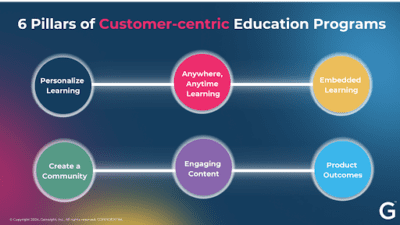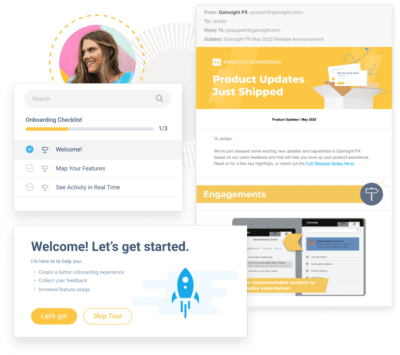Steve Jobs once said, “You’ve got to start with the customer experience and work back toward the technology, not the other way around.”
Jeff Bezos echoed that sentiment: “We see our customers as invited guests to a party, and we are the hosts. It’s our job every day to make every important aspect of the customer experience a little bit better.”
What do these two quotes share? They emphasize the importance of customer-centricity.
Now, if you’re saying, “Andrew, Apple, and Amazon are primarily B2C companies; their stances on customer-centricity don’t apply to my B2B customers.”
I won’t fight you there, but I’ll counter that with this quote from Microsoft’s CEO, Satya Nadella: Listen to your customers and your employees; they’re the most important thing and define your business.
This is a call to every B2B company with customers (aka all of them): Everything you do must be built around your customers, including how you educate them about your product. Today, and every day in the future, you can no longer think of customer education as a “check the box” tactic delivered in a transactional way.
It’s time to connect with your customers more than ever and deliver learning experiences that resonate and drive them to success—here’s how.
6 Ways to Put Your Customers at the Heart of Your Education Program
Before we dive into the core pillars of Gainsight’s customer-centric education strategy, I want to take you through an exercise (no actual exercise required, I promise).
Ask yourself: What do you expect in your personal life from the companies you interact with, and what do you value in those interactions?
I can’t read minds, but I bet your response included some of these:
- Personalization
- Convenience
- Engagement
- Flexibility
- Timeliness
These qualities are fundamental to the success of every B2C business. Amazon, for example, offers personalized product recommendations based on past purchases. At the same time, Uber oozes convenience by allowing anyone to grab a ride with a few clicks. Together, these companies and countless others have set the bar high—a bar your customer education program must meet.
That’s where the 6 pillars of customer-centric education come into play.

1. Respect Individual Rhythms of Life with Always-on Learning
Ready for another exercise?
Think of your closest friends and family. Do they have the same schedules? I still can’t read minds, but I can guarantee they don’t
- Susy, a hospital administrator, regularly works 12-hour shifts and her off days—and sleep schedule—are unpredictable.
- David’s the Chief Customer Officer (CCO) for an AI startup and constantly juggles meetings with customers across the globe.
- Eric, a Customer Success Manager (CSM), has a schedule that changes often to align with his customers’ evolving needs for onboarding, support, and strategy.
What’s my point? Everyone has different rhythms, which is why your customers need an on-demand academy that allows them to learn when and where it works for them.
2. Stimulate the Mind for Engaged Learning
The fifth pillar, creating engaging content, builds upon the collaborative pillar above. While some of your customers will prefer more traditional support, like 1:1 enablement sessions with their CSMs, introducing a more active learning approach will allow them to retain and apply the information more effectively.
I’m talking about:
- Quizzes that test your customers’ knowledge
- Instructor-led trainings (ILTs) that provide real-time and guided learning
- Short videos (microlearning) that offer quick insights
- Discussion forums and online communities (see above) the encourage peer-to-peer support
- Interactive tutorials and walkthrough that drive hands-on practice and skill application
Not only are these formats often more engaging than their traditional counterparts, but they can increase knowledge retention and skill application, which both translate to better product outcomes, ensuring your customers not only consume information, but apply it to their workflows.
3. Harmonize Learning with Product Outcomes
Speaking of product outcomes, the final pillar of customer-centric learning is all about focusing on outcomes, not features.
That means moving away from the vibe of traditional help centers that revolve around articles titled “What is feature X, Y, Z?” to content and courses designed to help customers achieve their actual outcomes.
Onboarding expert Donna Weber explained this idea on a recent webinar: “In the world of marketing, there’s a common saying that people don’t want to buy drills; they want quarter-inch holes.” Donna doesn’t agree with that thinking.
Instead, she says people are drilling holes in the wall for something, like securing a bookshelf. Said another way, they didn’t buy the drill just to put holes in the wall. Focusing your courses around features—like holes in the wall—misses the boat because it neglects the end goal or outcome your customers expect from your product.
So, ask yourself: What are your customers trying to accomplish with your product—and create content for those outcomes? For example, instead of creating a course titled “The Essentials of [Your Product Name]: A Deep Dive into Key Feature,” make one titled “Achieving Business Growth with [Your Product Name]: Strategies for Success.”
4. Unlock Personal Connections with Tailored Learning to Customers’ Challenges and Outcomes
Life is full of uncertainties, like whether or not you’ll find the missing sock in the dryer. However, one thing is certain: Your customers want personalized experiences, and many of them will switch vendors if you miss the boat.

To that end, go the extra mile to understand your customers so that you can ensure learning experience is directly related to their needs and challenges, and helps drive them to success with your product.
For example, if you’re selling CRM software, create role-specific onboarding learning paths—one that shows sellers how to maximize forecasting-related features and another to show marketers how to increase leads.
5. Honor the Natural Flow of Work with an Embedded Academy
Picture yourself at a hockey game. The game’s tied at 2 early in the third period, and suddenly, you have an urge for some popcorn—and the buttery goodness can’t wait.
So, what do you do? Hop up from your seat and awkwardly shuffle past others in your row. From there, you weave through the concourse, find the popcorn stand, wait in line, and then head back to your seat.
This isn’t an unrealistic scenario—the popcorn hunt is real. But here’s the thing: It’s inconvenient and interrupts the game’s natural flow (at least for you).
In this context, the ideal—and more seamless—option would be to wait for the popcorn vendor traversing the stands.
Now, consider the natural workflow of your customers when they want to learn about your product.
Would they rather:
- Leave your product, open a new tab, navigate to your academy, search for courses, take them, and then return to their original tasks.
- Access courses directly within your product with in-app guides, chatbots, an embedded academy that gives them access to the courses they need without disrupting their workflows, momentum, and train of thought.
The answer should be obvious. By embedding learning into your customers’ natural workflow—the third pillar of customer-centric learning—you ensure they stay engaged, productive with your product, and driving toward better outcomes.

Examples of in-app engagements via Gainsight PX
6. Nurture Growth Through Collaborative Learning
The facts supporting the impact of peer-to-peer learning are plentiful. For example, according to Forrester’s Sales and Customer-Facing Roles Survey, peer-to-peer interactions are critical for maximizing knowledge sharing. Meanwhile, students taught by traditional lecture-based learning were 1.5X more likely to fail than students participating in courses featuring active learning.
While these stats and studies aren’t tied directly to customer education, they underscore a key principle we can’t ignore: Collaboration and knowledge sharing just work.
This is why fostering a community where your customers can learn from each other and share knowledge is so important. A community can also give your customers a chance to feel a sense of ownership over your product by allowing them to submit product ideas and interact with your teams.
But that’s not the only benefit—your teams reap the benefits, too. By fostering a community and making your customers more self-sufficient, you’ll naturally reduce the reliance on support teams and CSMs, which can lead to substantial cost savings in the near- and long-term.
You may also like: BirchStreet Implements Blended Learning Capabilities to Decrease Support Costs and Drive Customer Satisfaction
You Don’t Need Every Pillar to Build a Sturdy Customer Education Program
Gainsight believes that the most customer-centric education programs are built upon a foundation of six key pillars:
- Personalize learning
- Making learning available anywhere, anytime
- Make learning a natural part of your customers’ workflow
- Foster growth through community and peer-to-peer learning
- Engage your customers with active learning
- Focus on outcomes, not product features
Together, these pillars allow you to deliver learning that empowers their customers and teams. But I want to make one thing clear: You don’t need every pillar to deliver a customer-centric experience, especially if you’re just starting out.
Instead, take a step back, evaluate where you are in your learning journey, pinpoint the pillars you and your team can implement today, and build from there.
Learn More
Ready to get started? Check out Gainsight Customer Education.


